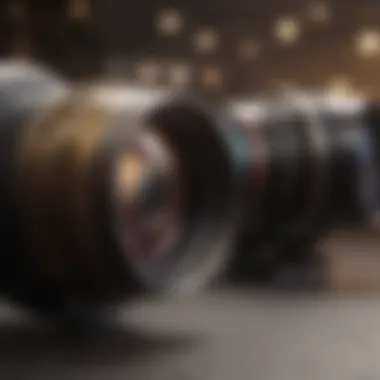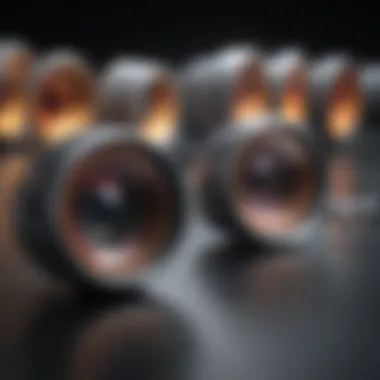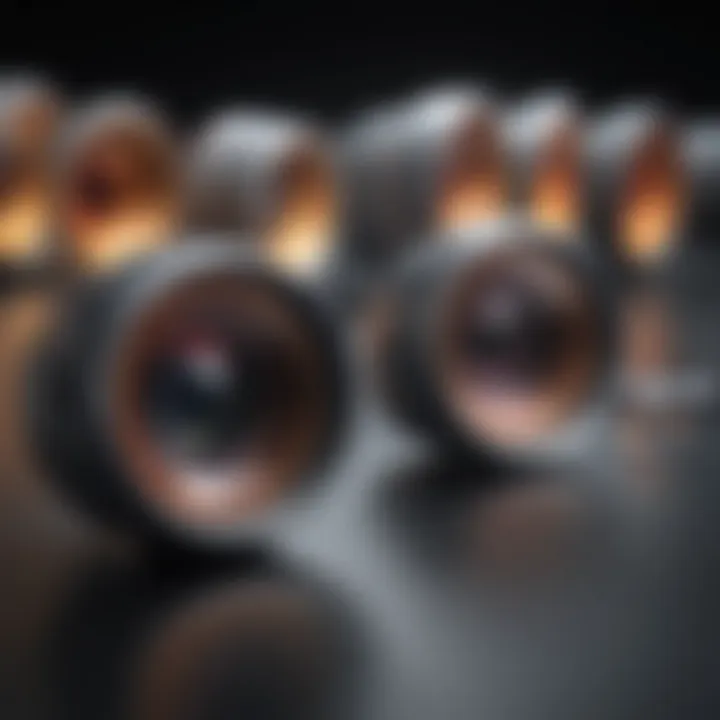Comprehensive Insights into Lens Design Techniques


Intro
Lens design plays a pivotal role in various fields, bridging the gap between theoretical optics and real-world applications. As technology has progressed, the demand for high-performance lenses has surged, leading to innovations that push the boundaries of what’s achievable. From photography to medical devices, understanding the principles behind lens design can unlock the door to improved clarity, precision, and versatility.
In this exploration, we will unpack the foundational aspects of lens design, tracing its historical roots to contemporary methods that incorporate advanced computational techniques. Our goal is to lay out a comprehensive framework that caters to students, researchers, educators, and professionals who are keen to delve into the intricate world of optics.
The journey begins by examining key findings that encapsulate the essence of lens technology. Among these are the fundamental optical principles that guide design choices, the historical context that shaped modern methodologies, and the innovative tools at our disposal today. From here, we'll dive into the methodology employed in lens design, digging into specific research designs and data-collection methods that contribute to lens performance evaluation.
Understanding this topic not only enriches one’s knowledge base but also enhances practical skills in diverse applications, reinforcing the significance of lens optics in a variety of industries.
Key Findings
Major Results
- Historical Evolution: The development of lens technology has roots dating back to ancient civilizations. Incremental advancements have led to the sophisticated manufacturing processes we see today.
- Optical Principles: A solid grasp of principles such as refraction and aberration is essential in lens design. These core concepts influence how light interacts with different materials, affecting clarity and precision.
- Modern Methods: The advent of computational modeling has opened doors for complex lens designs that were previously infeasible. Sophisticated simulations allow for rapid iterations and improvements in lens performance.
Discussion of Findings
The interplay between historical insights and modern innovations reveals significant trends. As lenses have evolved to cater to specific applications, their designs have become more specialized. For example, the spherical lens is commonly used in photography, while aspheric lenses are increasingly favored for reducing optical aberrations in cameras, microscopes, and even corrective eyeglasses.
Additionally, the exploration of new materials and coatings has dramatically improved lens efficiency. For instance, anti-reflective coatings enhance the transmission of light through the lens, optimizing performance for various visual tasks. This careful balance of design, materials, and coatings exemplifies the artistry and rigor that goes into modern lens making.
The significance of understanding lens design extends beyond theory; it is a practical guide to improving devices that many rely on every day, from medical instruments to personal cameras.
Methodology
Research Design
The research design for this exploration includes both qualitative and quantitative methods. These approaches provide a comprehensive outlook on lens technology, merging historical context with fresh insights based on current practices and innovations. By conducting literature reviews and examining case studies, we will present a robust analysis of lens design strategies, drawing conclusions that can inform future explorations in optical design.
Data Collection Methods
Data collection in lens design can take various forms, including:
- Literature Reviews: Analyzing past research for historical development and technical details.
- Surveys and Interviews: Engaging with experts in optics to gather first-hand insights about evolving trends and user requirements.
- Experimental Studies: Testing different lens materials and geometries to assess performance metrics such as clarity, distortion, and light transmission.
Such methods ensure that our understanding of lens design is well-rounded, revealing insights that are both practical and theoretical in nature. As we continue, we'll delve deeper into these findings, supporting the understanding of how lenses are crafted with precision for an array of applications.
Prelims to Lens Design
Understanding lens design is not just for the optics enthusiasts or the hardcore engineers among us. It is a fundamental aspect of countless fields—ranging from photography and healthcare to scientific research. Lens design merges art with science, crafting tools that perceive the world in unique ways, offering clarity and insight that would otherwise remain obscured. In this article, we dig into the layers of this intricate subject, unpacking the nuances that have shaped both the craft and the technology behind lenses.
The Importance of Lens Design
The significance of lens design can often be understated. At its core, proper lens design magnifies our capacity to observe, evaluate, and document phenomena. For example, a well-designed optical system can mean the difference between a medical professional detecting a microscopic organism or overlooking it entirely. Think about the intricacies in a camera lens; a slight misalignment could result in blurry images that fail to capture the moment. Optimal lens design enhances functionality, minimizes aberrations, and bolsters the efficiency of devices across sectors.
Moreover, advancements in lens design can lead to improved sustainability practices in manufacturing, crucial in today’s environmentally conscious consumer market.
Historical Context
The journey of lens design transports us back through the annals of history, revealing a tapestry woven with innovation and adaptation. From the early days of spectacle lenses crafted by artisans to the modern precision manufactured optics, every era has contributed to our current understanding.
Initially, lenses were mere glass pieces shaped to correct vision. Over time, notable figures like Galileo and Newton propelled advancements. Galileo utilized a convex lens to craft his telescope, effectively changing our grasp of the universe.
Fast forward to the 19th century, and you see a surge in industrialization, yielding exquisite precision tools for lens making. This period birthed the concept of achromatic lenses, which significantly reduced color distortion, enhancing clarity.
Each innovation in the field was a stepping stone towards the robust and multifaceted lens designs we see today. Every twist and turn in this history enriches our understanding and appreciation for how lenses shape the way we explore both science and art.
"Through every epoch, lens design has acted as a mirror reflecting our persistent pursuit of knowledge and clarity."
By exploring these foundational aspects of lens design, we position ourselves to appreciate not just the technology, but also the artistry that goes into creating the optical devices we often take for granted.
Fundamental Principles of Optics
Understanding the fundamental principles of optics is a cornerstone of lens design. Optics isn't just a set of complicated equations; it's the art and science of how light interacts with various materials. Whether it’s a basic camera lens or advanced imaging systems used in medical diagnostics, a solid grasp of optics principles is essential for creating effective designs.
Refraction and Reflection
At the heart of optics lies two primary phenomena: refraction and reflection. These principles govern how light behaves when it encounters different media.


- Refraction occurs when light passes from one medium to another, changing its speed and direction. Think about how a straw looks bent when it’s in a glass of water; that's refraction at play. This principle is crucial in lens design, as the ability to bend light determines how well a lens can focus or disperse light. For instance, in camera lenses, understanding the angle of incidence and the refractive indices of materials directly influences image clarity.
- Reflection, on the other hand, is the bouncing back of light when it meets a surface. Mirrors are a prime example of this principle. Knowing how multiple reflections can bring about various effects allows designers to create complex optical systems, like those found in telescopes and projectors. A deeper insight into what affects reflection, like surface texture and coating, can greatly improve lens performance.
"The advancement in optical design hinges on the delicate interplay between refraction and reflection, revealing how light can be manipulated to achieve desired outcomes."
Wave and Particle Theory of Light
The dual nature of light as both a wave and a particle is pivotal in optics. This duality opens doors to comprehending phenomena that are essential for lens design.
- Wave theory posits that light travels in waves and elaborates on concepts like interference and diffraction. These effects are particularly relevant when designing lenses that need to minimize aberrations. Designers can leverage this understanding to engineer lenses that interact with light waves, thereby ensuring sharper images and better optical performance.
- Particle theory, or the idea that light consists of particles called photons, brings another layer to optical design. This concept assists in explaining how light can transmit energy, impacting how lenses capture and direct light in cameras or sensors. For example, understanding how different wavelengths interact with materials enables designers to create optical filters for specific applications.
Both these theories emphasize the necessity of precision in lens manufacturing. Each aspect of light’s behavior must be accounted for, especially when striving for high-quality imaging systems needed in photography, medicine, and varying scientific applications.
Therefore, having a thorough comprehension of these fundamental principles not only enriches one's knowledge but also brings tangible benefits in the process of crafting high-performance lenses.
Types of Lenses
In the vast world of optics, understanding the various types of lenses is crucial for anyone engaged in the study or application of lens design. Each type of lens serves a unique purpose and is built on different principles of light behavior. This section focuses on the core categories, namely convex and concave lenses, along with an examination of specialty lenses, which include Fresnel and multifocal lenses. Knowing the distinct characteristics, advantages, and limitations of each type is pivotal.
Convex and Concave Lenses
Convex and concave lenses are fundamental building blocks in optics. Convex lenses, often referred to as converging lenses, are thicker at the center than at the edges. These lenses effectively bend light rays inward, bringing them to a focal point. This property is invaluable in applications like magnifying glasses, cameras, and eyeglasses for hyperopia (farsightedness). In contrast, concave lenses are thinner in the center and thicker at the edges, causing light rays to diverge. They are primarily used to correct myopia (nearsightedness) and in optical instruments like telescopes.
When selecting a lens type, consider not only the desired optical effect but also how the lens shape influences the overall design and efficiency of the optical system. Each lens type comes with its pros and cons, which can significantly affect light quality, focus, and image clarity in practical applications.
Specialty Lenses
Diving deeper into lens design, specialty lenses offer unique advantages that broaden their use in various fields. Two notable examples are Fresnel lenses and multifocal lenses.
Fresnel Lenses
Fresnel lenses are an innovative design that allows for a thinner and lighter lens. This lens consists of a series of concentric circles, or "steps", which bend light just as a thicker, traditional lens would. The key characteristic of Fresnel lenses is their ability to maintain a compact form while effectively focusing light. This makes them particularly advantageous in settings like lighthouses and overhead projectors, where space and weight are at a premium.
The lightweight and versatile nature of Fresnel lenses enable their use in various applications without compromising on efficiency.
However, one unique feature of Fresnel lenses is their susceptibility to chromatic and spherical aberrations. While they help reduce the overall thickness, these aberrations can lead to distorted images, which is a drawback in precision optics, necessitating careful design considerations.
Multifocal Lenses
On the other hand, multifocal lenses address a different challenge by providing multiple focal points in one lens. Designed primarily for reading glasses or bifocals, these lenses allow users to see clearly at varying distances without the need for multiple pairs of glasses. The defining characteristic of multifocal lenses is the seamless transition between varying optical prescriptions. This feature enhances convenience and comfort, especially in activities like reading or driving.
Nevertheless, multifocal lenses can present a learning curve. Some users may initially struggle with the perceived distortions at the lens edges. Over time, however, many adapt to the integrated design, appreciating the reduction in hassle that comes with switching glasses.
Finale
In summary, the exploration of types of lenses offers critical insights into lens design's multifaceted nature. Each type, from the basic convex and concave to the more specialized Fresnel and multifocal lenses, provides distinct benefits and limitations that cater to specific applications. Understanding their attributes and functionality is essential for anyone looking to grasp the complexities of optical design.
Materials Used in Lens Manufacturing
The materials chosen for lens manufacturing are not just trivial decisions; they greatly influence the performance and application of optical devices. Optics combines science and art, but the materials’ characteristics largely dictate how light interacts with a lens. In an era where precision is paramount, understanding different materials is crucial for achieving optimal results in lens design.
Optical Glass
Optical glass has long stood as a cornerstone in lens manufacturing. Its unique refractive properties make it a go-to material for high-quality lenses in various applications. Refraction, which allows lenses to bend light and form images, is significantly affected by the composition of the glass.
The clarity of optical glass surpasses many other materials, enabling minimal light distortion. This quality is vital for fields like photography and astronomy, where even minor aberrations can compromise image quality. Incorporating additives during production can alter the glass’s refractive index and dispersion, allowing designers to tailor lenses for specific use cases.
Moreover, optical glass tends to have high scratch resistance, which is vital for maintaining lens integrity over time. Photographers, for instance, often work in demanding environments, and a resilient lens can withstand the rigors of constant use. However, it’s not all sunshine—optical glass can be heavier than alternatives, posing challenges in design for specific applications like eyeglasses or compact cameras.
Plastics and Polycarbonate Materials
Plastics, particularly polycarbonate, have introduced a new dimension to lens manufacturing. These materials are lightweight, flexible, and can be produced with high clarity nearly comparable to glass. Their lightness makes them especially preferred in applications where reducing weight is crucial, such as sports eyewear or safety goggles.
Although plastics present significant advantages, they are not without their shortcomings. For instance, polycarbonate lenses are more prone to scratching than optical glass, necessitating additional protective coatings to enhance durability. This requirement can increase the total cost and manufacturing complexity but offers a trade-off for weight and versatility.
Another aspect worth noting in the discussion of plastics is their ease of production. They can be molded into various shapes and sizes, drastically reducing manufacturing time and costs compared to traditional glass lenses. This adaptability leads to rapid prototyping and the possibility of creating customized lenses tailored to specific needs, such as in therapeutic eyewear.
In summary, the selection of materials is foundational in lens manufacturing. Each category�—optical glass and plastics—comes with its distinctive features, benefits, and limitations. Manufacturers must assess these factors while designing lenses to meet the stringent demands of various applications.
"The material palette for lens design has evolved, but understanding the science behind each option empowers innovators to push boundaries."


Design Considerations
When delving into the intricacies of lens design, several critical factors come into play that influence how a lens will perform. Understanding design considerations is not just an academic exercise; it directly affects the quality of the images produced, the functionality of optical devices, and their broader applications in industries like photography, healthcare, and scientific research.
Focal Length and Aperture Size
Focal length is like the heartbeat of a lens; it determines how the lens gathers light and how the resulting image is rendered. Longer focal lengths allow for more distant subjects to be captured in detail, while shorter lengths are generally favorable for wider views. Think of it this way: a camera with a lens featuring a 200mm focal length is akin to having binoculars. You can zoom in on far-off subjects, capturing intricate details without moving closer.
The aperture size is another crucial player in this game. It refers to the lens opening that lets light enter. A larger aperture (like f/1.4) can gather more light, making it ideal for low-light environments or for achieving that desirable soft background effect, often referred to as 'bokeh.'
Conversely, a smaller aperture (like f/16) results in a greater depth of field, making more of the image appear sharp, which is beneficial for landscape photography. This interplay between focal length and aperture can drastically alter an image's final appearance, proving that careful consideration of these factors can help lens designers tailor products for specific uses.
Lens Shape and Profile
The physical shape and profile of a lens profoundly impact its optical performance. Generally, the curvature of a lens influences how light bends as it passes through. For instance, converging lenses are thicker in the center, making them effective for focusing light, while diverging lenses are thinner in the middle, dispersing light rays.
Moreover, the profile also includes considerations such as the lens's diameter and overall thickness. A wider lens can potentially collect more light, improving brightness, but at the cost of weight and size. It’s a balancing act between portability and performance. Designers must also think about the intended application of the lens. For example:
- Photography: Requires a fine balance between weight and optical performance, particularly for event shooting where speed is crucial.
- Medical Devices: May necessitate compact, precision optics to fit within instruments like endoscopes, ensuring both functionality and ease of use.
The shaping of the lens is not merely a cosmetic choice; it dramatically affects distortion levels and potential aberrations in the final image. By thoughtfully determining these design elements, professionals can enhance lens efficacy and cater to the specific needs of their end-users.
"Good lens design is like crafting a fine instrument; even the smallest detail can mean the difference between clarity and chaos"
In essence, focusing on design considerations when crafting lenses ensures that they meet the diverse demands of modern applications, paving the way for advancements that are both technically sound and user-friendly.
Optical Aberrations
Optical aberrations represent a fundamental challenge in lens design, impacting both the quality and performance of optical systems. Without a solid grasp of these aberrations and their implications, designers can easily find themselves in a bind, leading to distorted images or compromised functionality. This section aims to shed light on various types of optical aberrations and discuss methods of correcting them. By understanding these imperfections, we’ll highlight the critical role they play in shaping the efficacy of a lens, whether it’s in photography, medical devices, or scientific instruments.
Types of Aberrations
There are several types of optical aberrations, each with its distinct causes and effects:
- Spherical Aberration: Occurs when light rays striking a lens at differing distances from the optical axis do not converge at a single point. The result can be a blurred or haloed image, specifically notable at the edges of the frame.
- Chromatic Aberration: This one arises from the lens having different refractive indexes for various wavelengths of light. Consequently, different colors focus at disparate points, leading to fringes of coloration around bright objects. This can detract from the overall sharpness of an image.
- Comatic Aberration: Commonly seen in off-axis images (like the night sky), this aberration resembles a comet's tail, thus its name. Comatic aberration produces a streaking effect where points of light appear elongated instead of resulting in crisp points.
"Optical aberrations can turn a crystal-clear vision into a cloudy mess if not addressed properly."
- Field Curvature: This happens when a flat object appears distorted or hazy due to the image not aligning with the flat image sensor. It's as if the scene is wrapped around a dome, causing challenges in achieving uniform focus across the entire frame.
- Distortion: This aberration alters image proportions. It can manifest as barrel or pincushion distortion, where straight lines curve outward or inward akin to an exaggerated effect, leading to a non-true-to-life depiction of subjects.
Understanding these aberrations is key for lens designers. By recognizing where and how each type occurs, they can tailor designs to offset or mitigate these issues in real-world applications.
Correcting Aberrations
Addressing optical aberrations is more of an art and science combined. Designers and engineers employ various strategies to correct these imperfections, ensuring the final product meets high standards of optical clarity and performance. Here are some common methods:
- Lens Shape Modification: The curvature of the lens can be adjusted to counteract spherical aberration. By utilizing aspheric lenses—lenses with a non-spherical shape—designers can significantly reduce this aberration.
- Material Selection: Different optical glasses possess varying dispersive qualities. By selecting materials with specific refractive index profiles, designers can minimize chromatic aberration. High-quality glass such as those used in Leica lenses often comes into play.
- Compound Lenses: Using a combination of convex and concave lenses can help in balancing out multiple types of aberrations simultaneously. This method allows the unique properties of each lens type to complement each other.
- Corrective Filters and Lens Elements: Chromatic aberrations can be handled with specialized filters that selectively absorb specific wavelengths or additional lens elements designed to disperse light uniformly.
- Optical Software: Today’s advanced computational tools facilitate the simulation of various lenses' performance. Ray tracing software can predict where aberrations will likely arise and enable adjustments before any physical prototypes are created.
Tackling optical aberrations is an indispensable facet of lens design. As technology continues to evolve, so do the methods for correcting these aberrations, leading to enhanced image quality and precise optical instruments.
Technological Advances in Lens Design
In the realm of lens design, technological advancements play an instrumental role in pushing the boundaries of what can be achieved. As the demand for higher-quality optics increases across various sectors like photography, medicine, and research, staying abreast of the latest innovations in lens technology is critical. These advances not only enhance performance but also cater to more specific needs, leading to the development of custom solutions that meet the demands of complex applications.
Computational Design Techniques
Ray Tracing
Ray tracing has emerged as a cornerstone in computational lens design, primarily due to its ability to render light paths with remarkable accuracy. This technique simulates the behavior of light as it travels through different media, allowing designers to visualize how modifications to lens shape and materials will affect image quality. One of the key characteristics of ray tracing is its capacity to trace numerous rays simultaneously, providing comprehensive data on how light interacts with a lens system.
Because it effectively models imperfections and aberrations, ray tracing is a favored choice among lens designers. By revealing problematic areas in a design, it allows for more informed adjustments and refinements. However, it does come with its challenges. Ray tracing requires substantial computational power and time, particularly when dealing with complex scenarios involving multiple lenses. Despite the drawbacks, its precision makes it indispensable in achieving high-performance lenses.
Optimization Algorithms
On the other hand, optimization algorithms serve to streamline the lens design process, enhancing both the functionality and efficiency of lens systems. These algorithms work by adjusting numerous parameters—like curvature, thickness, and spacing—to achieve desired optical properties. The beauty of optimization algorithms lies in their ability to quickly evaluate vast combinations of design variables, often leading to novel designs that would not have been considered using traditional methods.
What sets optimization algorithms apart is their adaptability. They can incorporate real-time feedback and automatically adjust based on performance criteria set by the user. Although extremely advantageous, these algorithms can sometimes produce solutions that are theoretical in nature, potentially lacking practical feasibility. Nevertheless, their role in significantly reducing design time while enhancing overall performance is undeniable.
3D Printing in Lens Production


The introduction of 3D printing technology in lens production marks another substantial shift in how lenses are designed and fabricated. By enabling rapid prototyping and production, 3D printing allows designers to iterate designs at an unprecedented pace. The ability to manufacture custom lenses tailored to specific applications is particularly noteworthy, as it enables both niche markets and large-scale productions to benefit significantly.
By employing various materials—from polymers to glass—the technology caters to a broad spectrum of requirements. This flexibility not only supports light-weight designs but also makes it possible to merge various optical properties into a single lens. However, challenges remain in terms of the surface finishes achieved through 3D printing, which may require additional post-processing to meet certain optical standards. Yet, the prospects for personalized or rapidly adaptable lens designs continue to fuel excitement and exploration in this arena.
"The advances in lens design, driven by technology, are not only reshaping optics but are also influencing how we perceive and utilize the world around us."
In summary, the strides made in computational design techniques through ray tracing and optimization algorithms, along with innovations such as 3D printing, lay the groundwork for the future of lens design. They create opportunities for designers to push the envelope and provide integral solutions across various fields.
Applications of Lens Design
The realm of lens design is not confined to mere theoretical frameworks or laboratory experimentation; its implications stretch far into various domains, marking significant impacts across disciplines. This section sheds light on the versatile applications of lenses, illustrating their essential relevance in modern society. By understanding the pivotal roles lenses play in photography, healthcare, and scientific research, one can appreciate the complexity and craftsmanship that underlie lens design.
Photography and Cinematography
In the world of photography and cinematography, lenses serve as the gateway to visual storytelling. The choice of lens can drastically affect the composition and emotional resonance of an image. For instance, a prime lens often yields sharper images compared to a zoom lens, making it the preferred option in high-end portraits where clarity and detail are paramount. Meanwhile, wide-angle lenses can create a sense of depth and expansiveness, ideal for landscapes.
Moreover, specialty lenses, such as tilt-shift lenses, allow photographers to manipulate perspective and depth of field, crafting unique visual narratives that challenge conventional representational norms. As demand for higher resolutions grows, manufacturers have stepped up the game, incorporating materials that reduce chromatic aberration and distortions while enhancing contrast and color fidelity. Consequently, this focus on lens quality often translates to more engaging and visually arresting experiences for the viewer.
Medical Instruments and Devices
Within the medical field, lenses are integral to various diagnostic and treatment instruments. Surgical microscopes, endoscopes, and diagnostic imaging equipment rely heavily on precisely designed lenses to ensure accuracy in diagnosis and effectiveness in treatment. For example, in ophthalmology, the use of specialized lenses during procedures like cataract surgeries exemplifies how lens technology can vastly enhance patient outcomes.
A keen understanding of lens design principles allows developers to create tools that provide magnification without distortion, proving invaluable in a range of surgical applications. This precision is not just a matter of aesthetics; it is critical for ensuring that healthcare professionals can see the intricate details they need to make informed decisions during procedures.
Scientific Research and Instrumentation
In scientific endeavors, lenses draw attention for their role in instrumentation like microscopes and telescopes, which enable researchers to explore the minutiae of the microscopic world and the expanses of the universe, respectively. High-performance lenses designed for microscopes help scientists distinguish minute structures and processes in biology, chemistry, and materials science. For instance, high numerical aperture lenses can collect more light and resolve smaller details, culminating in clearer and more informative images.
In astronomy, the design of lenses immensely affects the performance of telescopes, extending our capacity to observe cosmic bodies at great distances. The advancement of multi-element lens systems has allowed astronomers to eliminate chromatic aberrations and improve focus across various wavelengths of light, resulting in more accurate interpretations of celestial phenomena.
"In both the microscopic and astronomical realms, the quality of lens design can determine the clarity of our understanding of the universe and its complexities."
Ultimately, lens design is not just a technical exercise; it profoundly influences how we interact with the world, from capturing memories in photographs to advancing medical treatments and expanding our knowledge of the universe. Each application underscores the remarkable utility of meticulously engineered lenses in shaping our perception and understanding of reality.
The Future of Lens Design
As we venture deeper into an epoch marked by relentless technological evolution, the discussion surrounding The Future of Lens Design becomes increasingly relevant. This topic is not mere speculation; it reflects a growing convergence of various fields such as chemistry, physics, and even software engineering. We will explore emerging technologies and sustainability movements that are poised to redefine the landscape of lens design.
Emerging Technologies
The role of emerging technologies in lens design cannot be overstated. Current trends indicate a marked shift towards integrating new materials and advanced fabrication techniques, heralding a new era in the optical domain.
- Adaptive Lenses: Imagine lenses that can change their optical properties in real-time. Technologies like liquid crystal display (LCD) and electrowetting could pave the way for adaptive lenses that offer varying levels of focus or tint based on environmental conditions or user needs.
- Nanotechnology: Innovations at the nanoscale are taking center stage. Coatings that minimize reflections and enhance durability are now being engineered at the molecular level. This could lead to breakthroughs in how we perceive color and sharpness in our visual fields.
- Artificial Intelligence (AI): AI may emerge as a game-changer in lens design. By employing machine learning algorithms, designers could analyze vast data sets to optimize lens parameters with precision, predicting performance metrics that were previously hard to gauge. This form of predictive modeling is likely to save both time and resources in the design process.
- Biomimetic Materials: Nature has often served as a guide for engineering solutions. Firms are increasingly looking at bio-inspired materials that mimic natural optical structures, like the compound eyes of insects, to create multifunctional lenses that offer superior performance.
The melding of these technologies will likely introduce lenses that are not just functional but also highly adaptable to diverse and demanding applications.
Sustainability in Lens Production
As our awareness of environmental issues continues to grow, the optics industry is grappling with the need for more sustainable practices in lens production. The path forward is laden with challenges, yet ripe with opportunities for innovation.
- Recyclable Materials: Traditional lens materials often pose environmental risks. The future will likely see a shift towards recyclable optical plastics and glass, significantly reducing waste in the manufacturing process.
- Energy-Efficient Production: Manufacturers are seeking ways to reduce energy consumption. Techniques such as additive manufacturing, or 3D printing, not only streamline production but also minimize surplus material.
- Eco-Friendly Coatings: The application of harmful chemicals during coating processes is another area of concern. Future coatings that are non-toxic and biodegradable will contribute to more responsible lens production.
- Localized Production: By decentralizing production, lens makers can reduce transportation emissions and focus on lower-impact logistics. Localized sourcing of materials can also bolster local economies and promote regional innovation.
In sum, the sustainability movement will shape the future of lens design, forging a path towards responsible innovation. More than a fleeting trend, these changes could redefine the industry's standards and practices for generations to come.
In the intricate tapestry of lens design, emerging technologies and sustainability are interwoven threads that will determine not only future innovations but also the ethical fabric of the industry.
Harnessing advances while embracing environmental responsibility serves not just as a business imperative but as a moral obligation, especially for those enterprises vying for leadership in an increasingly conscious marketplace.
The End
The conclusion of this article serves as a vital component in understanding the broader implications of lens design. This synthesis not only emphasizes how far technology has come but also highlights the critical link between theoretical and practical advancements in the field. The design of lenses shapes not only visual clarity but also impacts sectors ranging from medicine to photography, ultimately influencing how we interact with the world.
Recap of Key Points
To successfully summarize the preceding discussions, we've ventured through various stages of lens design:
- Historical Evolution: Examining the roots of lens technology, we appreciate the strides made over centuries, setting the stage for modern advancements.
- Fundamental Optics: Concepts such as refraction and reflection are foundational, guiding every design decision from basic to complex lenses.
- Diverse Types of Lenses: From convex and concave to multifocal lenses, the variety available suits specific applications, with each serving particular needs.
- Material Selection: Choosing the right materials, whether optical glass or polycarbonate, can dramatically enhance or hinder lens performance.
- Design Methodologies: The integration of technological advances like 3D printing and computational design has revolutionized how lenses are crafted.
These aspects all contribute to the continuous evolution of lens design, showcasing a blend of science, tradition, and innovation.
The Significance of Ongoing Research
The persistence of research within lens design is paramount. As new challenges arise, such as improving sustainability in material production or enhancing optical efficiency, research paves the way for solutions. Significantly, ongoing studies foster the development of smarter and more adaptable lenses, addressing modern-day needs like augmented reality and high-precision medical tools.
"Investing in lens design research today leads to advancements that can shape our vision of tomorrow."
In sum, the work being done today lays the groundwork for future innovations. As students, researchers, educators, and professionals explore these nuances, they contribute to a legacy of growth and excellence in the world of optics.



